Hi, what do you want to do?
Grammarly
Grammarly Blog: Comma Between Correlative Conjunction Sets
This page provides the rules and exceptions for the use of commas when using corratative conjuction sets such as either or, or neither nor, or not only but also. No commas are needed between them unless the comma is needed for other...
Grammarly
Grammarly Blog: Geographical Use of Definite Article The
This page provides rules for when to use and not use the article "the."
Grammarly
Grammarly Blog: Everyone vs. Every One
This article provides the rules for the proper use of the words "everyone" and "every one" with examples.
Grammarly
Grammarly Blog: Comma Before But
This page focuses on the use of a comma before the coordinating conjunction "but" only if it is in front of an independent clause. Examples of proper and improper uses are provided.
Grammarly
Grammarly Blog: Comma in Dates
This page focuses on the use of commas when writing dates; a comma is used to separate the day from the month, and the date from the year. Examples are provided.
Grammarly
Grammarly Blog: Comma After Question Mark
This page explains how to puctuate a direct quotation that ends in a question mark or an explanation point. If the quote comes before the attributive tag, no comma is needed; if the attributive tag comes before the quote, a comma is...
Grammarly
Grammarly Blog: Comma Splice
This page focuses on the misuse of commas by using them to connect two independent clauses, resulting in a comma splice. It offers examples and suggestions for correcting them. It also provides exceptions to the rule with examples.
Grammarly
Grammarly Blog: Comma With Subjects and Verbs
This page focuses on the misuse of a comma when it is used to separate the subject of the sentence from the verb. It provides examples of such sentences and one exception to the rule.
Grammarly
Grammarly Blog: Comma After Introductory Clauses
Rules and examples for using commas correctly with an introductory clause.
Grammarly
Grammarly Blog: Comma Use Around Interrupters
This page focuses on the need for commas around interrupters in sentences and provides examples. Common interrupters include in fact, to say the least, however, generally speaking, sadly, happily, and unfortunately. Nouns of address can...
Grammarly
Grammarly Blog: Capitalization: The First Word in a Direct Quote Sentence
This page explains the rules for capitalizing direct quotes; if the quote is a sentence, capitalize it. If the quote is not a complete sentence, capitalize only what was capitalized in the original direct quote.
Robin L. Simmons
Grammar Bytes: Word Choice: Exercise 1: Their, There, and They're
Complete these 20 sentences by choosing the correct form of their, there, and they're.
Goodwill
Gcf Global: Quotation Marks
This tutorial illustrates when it's appropriate to use quotation marks in your writing.
ClassFlow
Class Flow: Comma's Worksheet (Coordinate Adjectives Part 1)
[Free Registration/Login Required] Use this worksheet to practice rewriting sentences to separate coordinating adjectives with a comma.
PBS
Pbs: How to Use Commas for Yes, No, Tag Questions, and Direct Address
Models how to use commas with offset elements such as yes, no, or a tag question. Includes downloadable reference sheet, a short student exercise, and an answer key for the teacher.
English Worksheets Land
English Worksheets Land: Use Commas in Addresses
Fifteen printable worksheets on commas in addresses should give students plenty of practice on this punctuation rule.
Grammarly
Grammarly Blog: Who and Whom
This page focuses on correctly using who or whom. Since who is a subjective pronoun, you can try replacing it with another subjective pronoun such as he or she to see how it sounds. Whom is an objective pronoun and can be replaced with...
Alabama Learning Exchange
Alex: Quotations and Commas
During this lesson students will have the opportunity to learn the proper way to use quotations and commas. They will view information on the Internet and participate in online activities to help them master this concept.
PBS
Pbs Learning Media: Using Commas and Quotations
Quotations and commas are two very useful punctuation tools that indicate dialogue and brief pausing in sentences. Learn how to use them correctly! [0:46]
PBS
Pbs Learning Media: Make Sure Your Subjects and Verbs Agree
A verb is the action word of the sentence and it must agree with the subject, or main character, of the sentence. When the subject is singular, a verb needs an "s", but when the subject is plural, we can drop the "s". [0:41]
PBS
Pbs Learning Media: How to Use Commas for Introductory Elements
Introductory elements are clauses, phrases, and words that appear before the main part of a sentence. Without commas, the reader may be confused. Use commas to indicate properly the who and the what. [0:40]
PBS
Pbs Learning Media: Interjections Are Cool!
Hey! Listen to this. [0:48] Interjections are words that are typically exclaimed to convey the writer's sentiments or emotions on a matter. It may be followed by an exclamation point or a comma depending on the desired emotion.
Khan Academy
Khan Academy: Salutations, Valedictions, Dates, and Addresses
Commas are needed when starting or ending a letter/email, writing out dates, or writing out addresses.
Khan Academy
Khan Academy: Recognizing Run Ons and Comma Splices
Run-on sentences and comma splices happen when a writer isn't careful with commas. Let's see how you do!























